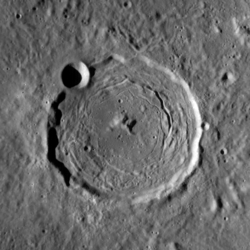| Display title | Astronomy:Taruntius (crater) |
| Default sort key | Taruntius (crater) |
| Page length (in bytes) | 9,883 |
| Namespace ID | 3024 |
| Namespace | Astronomy |
| Page ID | 593130 |
| Page content language | en - English |
| Page content model | wikitext |
| Indexing by robots | Allowed |
| Number of redirects to this page | 0 |
| Counted as a content page | Yes |
| Page image |  |
| HandWiki item ID | None |
| Edit | Allow all users (infinite) |
| Move | Allow all users (infinite) |
| Page creator | imported>Steve Marsio |
| Date of page creation | 13:11, 6 February 2024 |
| Latest editor | imported>Steve Marsio |
| Date of latest edit | 13:11, 6 February 2024 |
| Total number of edits | 1 |
| Recent number of edits (within past 90 days) | 0 |
| Recent number of distinct authors | 0 |
Description | Content |
Article description: (description)
This attribute controls the content of the description and og:description elements. | Taruntius is a lunar impact crater on the northwestern edge of Mare Fecunditatis. It was named after ancient Roman philosopher, mathematician and astrologer Lucius Tarutius Firmanus. To the northwest is the lava-flooded crater Lawrence, and to the north lie the craters Watts and da Vinci. |

